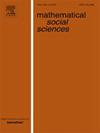The dynamics of bargaining power in a principal-agent model
IF 0.7
4区 经济学
Q4 ECONOMICS
引用次数: 0
Abstract
This article develops a dynamic principal–agent model that integrates bargaining power as an evolving state variable, governed by a bargaining drift coefficient that links its trajectory to firm performance and agent compensation. The model examines how initial bargaining power shapes salary trajectories and how bargaining drift influences its adaptation over time in response to performance outcomes. By modeling these dynamics, the study highlights the role of incentives in driving the evolution of bargaining power, emphasizing the long-term impact of initial conditions on compensation structures. A key contribution is the formulation of an empirical equation that connects agent compensation and performance with bargaining drift, offering a framework for real-world validation. Beyond CEO pay, the framework extends to other performance-based environments, such as sports and academia, where shifting power relationships shape long-term contracts. By introducing a computational algorithm for multiobjective optimization, the study enhances the practical implementation of bargaining power dynamics, offering valuable insights for both theoretical modeling and governance applications.

委托代理模型中议价能力的动态
本文开发了一个动态委托代理模型,该模型将议价能力作为一个不断变化的状态变量,由议价漂移系数控制,该系数将其轨迹与企业绩效和代理人薪酬联系起来。该模型考察了初始议价能力如何塑造薪酬轨迹,以及议价漂移如何随着时间的推移影响其对绩效结果的适应。通过对这些动态建模,该研究强调了激励在推动议价能力演变中的作用,强调了初始条件对薪酬结构的长期影响。一个关键的贡献是建立了一个经验方程,将代理人的报酬和绩效与议价漂移联系起来,为现实世界的验证提供了一个框架。除了CEO薪酬,该框架还适用于其他基于绩效的环境,比如体育和学术界,在这些领域,权力关系的变化会影响长期合同。通过引入多目标优化的计算算法,该研究增强了议价能力动力学的实际实施,为理论建模和治理应用提供了有价值的见解。
本文章由计算机程序翻译,如有差异,请以英文原文为准。
求助全文
约1分钟内获得全文
求助全文
来源期刊

Mathematical Social Sciences
数学-数学跨学科应用
CiteScore
1.30
自引率
0.00%
发文量
55
审稿时长
59 days
期刊介绍:
The international, interdisciplinary journal Mathematical Social Sciences publishes original research articles, survey papers, short notes and book reviews. The journal emphasizes the unity of mathematical modelling in economics, psychology, political sciences, sociology and other social sciences.
Topics of particular interest include the fundamental aspects of choice, information, and preferences (decision science) and of interaction (game theory and economic theory), the measurement of utility, welfare and inequality, the formal theories of justice and implementation, voting rules, cooperative games, fair division, cost allocation, bargaining, matching, social networks, and evolutionary and other dynamics models.
Papers published by the journal are mathematically rigorous but no bounds, from above or from below, limits their technical level. All mathematical techniques may be used. The articles should be self-contained and readable by social scientists trained in mathematics.
 求助内容:
求助内容: 应助结果提醒方式:
应助结果提醒方式:


